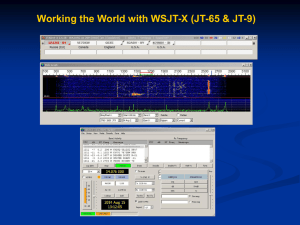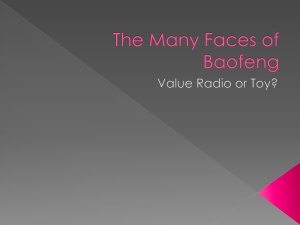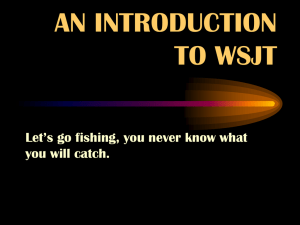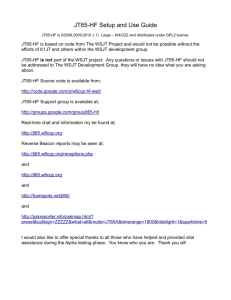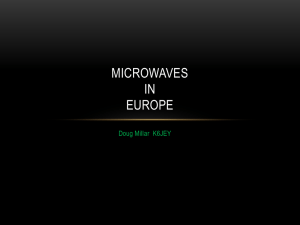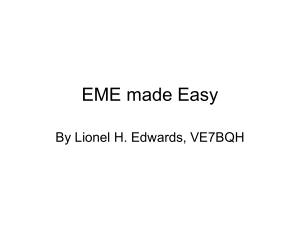PPTX
advertisement
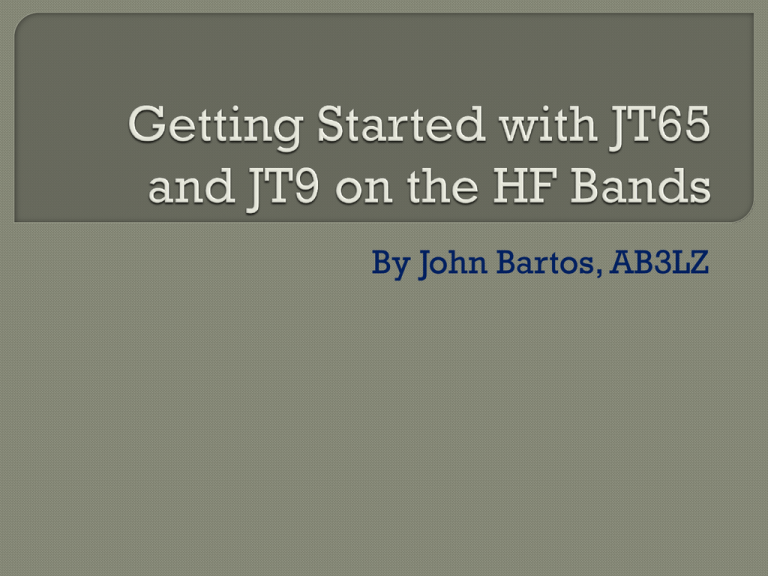
By John Bartos, AB3LZ A form of digital communications originally developed by Joe Taylor, K1JT, for Moon-bounce (EME) applications where signals are extremely weak (VHF/UHF). Uses sophisticated digital signal processing Also relies on redundancy – it sends the information over and over Licensed as a teenager (K2IPT). A math wiz whose interest in radios led to a career in radio astronomy. Co-discoverer of the first pulsar in a binary system. Tracked shrinking orbit of this binary system for 30 years. Orbit was shrinking due to mass transfers. Proved the orbit shrinking and mass loss was due to gravitational radiation. Predicted by Einstein's Theory of General Relativity to an accuracy of 1%. First to prove the existence of gravitational radiation. Awarded the Noble Prize in physics in 1993. Retired physicist/professor but still an active ham working on weak signal recognition. A 1270.5 Hz synchronizing tone 64 additional tones to carry the information (FSK) On the air it sounds like someone playing music Each JT65 transmission lasts precisely 46.8 seconds. During transmission only a small amount of information is sent – about 13 characters Station clocks must agree within about 1 seconds (Accurate time is important) As much as 80% of the transmission can be lost and still be decoded Stations Stations take turns transmitting transmit on even or odd UTC minutes, and then listen on the following minutes A JT65 contact is designed to exchange the bare minimum information needed to qualify as a “QSO” Call signs Signal Reports Grid Squares Program written by K1JT to facilitate weak signal VHF/UHF communications. Supported 4 communication protocols: • FSK441: for meteor scatter • JT6M: for ionospheric scatter • JT-65: for EME at VHF/UHF and for HF skywave propagation • JT4: For EME and tropospheric propagation on microwave bands Not user friendly. The JT65 “revolution” on the HF bands is primarily due to Joe Large, W6CQZ. Joe wrote a piece of software called JT65HF that makes it much easier to operate JT65 and make successful contacts. JT65-HF is currently available for Windows only. Excellent mode for low power or antenna restricted stations. Joe Taylor wrote user friendly software adapting the original VHF/UHF program (WSJT) to HF operation. Joe has also developed WSJT-X which decodes both JT-65 and JT-9. Programs available for Windows and MAC OS. Source code is available to compile on LINUX operating systems. JT9 is a new weak signal protocol for HF, MF and LF use. Functionally similar to JT65 Differences: • 9 tones in lieu of 65. • BW of 15.6 HZ in lieu of ~185 HZ. • JT65 decoder clamped at -1dB and JT9 decoder good to +49dB. (JT9 decoder linear over a large range) • JT65 S/N threshold is -25dB vs. the JT9 threshold @ 27dB. Software modes. operation identical for both WSJT-X uses color highlighting to indicate which stations are calling CQ, which stations are in contact with each other, and which stations are transmitting to you. The program also has preformatted responses that you can send by simply double clicking on the appropriate line. WSJT-X Control Panel JT-65 Water Fall & FFT JT-9 Water Fall & FFT I made this contact while running just 15W on 20 meters using 24 ft. vertical wire running up my chimney. UTC – When the signal was received. dB - The strength (S/N) of the received signal in dB. Higher is better. -1 is the upper limit. DT – The calculated offset of the received signal from your local clock. Values of .3 to 1.9 are typical. Freq – Offset in Hz from the center point (0). # @ – # is a JT65 decode and @ is a JT9 decode. Message – Information exchange. DXCC Worked All States Worked All Continents eQSL Awards Also supported by ARRL’s Logbook of The World SSB Transceiver Computer Interface with sound device WSJT-x • http://www.physics.princeton.edu/pulsar/K1JT/wsjt. html • http://www.physics.princeton.edu/pulsar/K1JT/WSJT -X_Users_Guide_v1.1.pdf • http://obriensweb.com/wsjtx.html (The Old Codger’s Guide to JT65 and JT9 via WSJT-X Software) JT65-HF • http://jt65-hf/downloads/ Clock Programs (Time is Important) • http://www.satsignal.eu/ntp/setup.html (Meinberg NTP) • http://www.thinkman.com/dimension4/ http://pskreporter.info/pskmap.html % Power = 100% X anti log (db/10) % Voltage = 100% X anti log (db/20) S/N Ratio with respect to power received: 0 db = 100% (signal power =100% of noise power) -5 db = 31.6% (signal power =31.6% of noise power) -10 db = 10% (signal power =10% of noise power) -15 db = 3.1% (signal power =3.1% of noise power) - 20 db = 1.0% (signal power =1.0% of noise power) -25 db = 0.32% (signal power =0.32% of noise power) -27 db = 0.2% (signal power =0.2% of noise power) Questions and Comments
